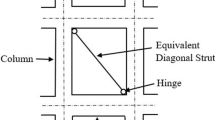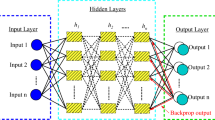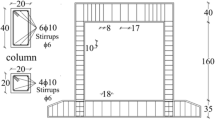Abstract
The seismic evaluation of existing buildings is a more difficult task than the seismic design of new buildings. Non-linear methods are needed if realistic results are to be obtained. However, the application to real complex structures of various evaluation procedures, which have usually been tested on highly idealized structural models, is by no means straightforward. In the paper, a practice-oriented procedure for the seismic evaluation of building structures, based on the N2 method, is presented, together with the application of this method to an existing multi-storey reinforced concrete building. This building, which is asymmetric in plan and irregular in elevation, consists of structural walls and frames. It was designed in 1962 for gravity loads and a minimum horizontal loading (2% of the total weight). The main results presented in terms of the global and local seismic demands are compared with the results of non-linear dynamic response-history analyses. As expected, the structure would fail if subjected to the design seismic action according to Eurocode 8. The shear capacity of the structural walls is the most critical. If the shear capacity of these elements was adequate, the structure would be able to survive the design ground motion according to Eurocode 8, in spite of the very low level of design horizontal forces. The applied approach proved to be a feasible tool for the seismic evaluation of complex structures. However, due to the large randomness and uncertainty which are involved in the determination of both the seismic demand and the seismic capacity, only rough estimates of the seismic behaviour of such structures can be obtained.
Similar content being viewed by others
References
ACI 318-08 (2007) Building code requirements for structural concrete and commentar. An ACI standard, American Concrete Institute, Farmington Hills
Ambraseys N, Smit P, Sigbjörnsson R, Suhadolc P, Margaris B (2002) Internet-site for European strong-motion data. European Commission, Directorate-General XII, Environmental and Climate Programme, Brussels. http://www.isesd.cv.ic.ac.uk
Bardakis VG, Dritsos SE (2007) Evaluating assumptions for seismic assessment of existing buildnig. Soil Dyn Earthq Eng 27: 223–233. doi:10.1016/j.soildyn.2006.07.001
Calvi GM, Pavese A, Rasulo A, Bolognini D (2005) Experimental and numerical studies on the seismic response of R.C. hollow bridge piers. Bull Earthq Eng 3: 67–297. doi:10.1007/s10518-005-2240-0
CEN (2004) Eurocode 8—design of structures for earthquake resistance. Part 1: general rules, seismic actions and rules for buildings. European standard EN 1998-1, December 2004, European Committee for Standardization, Brussels
CEN (2005) Eurocode 8—design of structures for earthquake resistance. Part 3: assessment and retrofitting of buildings. European standard EN 1998-3. June 2005. European Committee for Standardization, Brussels
CSI (2006) PERFORM 3D nonlinear analysis and performance assessment for 3D structures. Computers & Structures Inc, Berkeley
FEMA356 (2000) Prestandard and commentary for the seismic rehabilitation of buildings. Federal Emergency Management Agency, Washington
Fajfar P (2000) A nonlinear analysis method for performance-based seismic design. Earthq Spectra 16(3): 573–592. doi:10.1193/1.1586128
Fajfar P, Marušić D, Peruš I (2005) Torsional effects in the pushover-based seismic analysis of buildings. J Earthq Eng 9(6): 831–854. doi:10.1080/13632460509350568
Ghobarah A (2000) Seismic assessment of existing structures. Prog Struct Eng Mater 2(1): 60–71
Isaković T, Bevc L, Fischinger M (2008) Modeling the cyclic flexural and shear response of the R. C. hollow box columns of an existing viaduct. J Earthq Eng 12(7): 1120–1138. doi:10.1080/13632460802003587
Kowalsky MJ, Priestley MJN (2000) Improved analytical model for shear strength of circular reinforced concrete columns in seismic regions. ACI Struct J 97: 388–396
Kreslin M, Dolšek M, Fajfar P (2006) Matematično modeliranje in analiza armiranobetonske stavbe po EC8 = mathematical modeling and analysis of a reinforced concrete building according to EC8. Gradbeni vestnik (in Slovenian) 55(6): 141–152
Kreslin M, Dolšek M, Fajfar P (2008) Seismic analyses of an irregular existing RC building. In: Proceedings of the Workshop on the seismic behaviour of Irregular and Complex Structures. Catania
Lupoi G, Calvi GM, Lupoi A, Pinto PE (2004) Comparison of different aproaches for seismic assessment of existing buildings. J Earthq Eng 8(1): 121–160. doi:10.1142/S1363246904001626
Mergos PE, Kappos AJ (2008) A distributed shear and flexural flexibility model with shear—flexure interaction for R/C members subjected to seismic loading. Earthq Eng Struct Dyn 37(12): 1349–1370. doi:10.1002/eqe.812
Panagiotakos TB, Fardis MN (2004) Seismic performance of RC frame designed to Eurocode 8 or to the Greek Codes 2000. Bull Earthq Eng 2: 221–259. doi:10.1007/s10518-004-2288-2
Peruš I, Poljanšek K, Fajfar P (2006) Flexural deformation capacity of rectangular RC columns in flexure by the CAE method. Earthq Eng Struct Dyn 35(12): 1453–1470. doi:10.1002/eqe.584
Priestley MJN, Verma R, Xiao Y (1994) Seismic shear strength of reinforced concrete columns. J Struct Eng ASCE 120(8): 2310–2329. doi:10.1061/(ASCE)0733-9445(1994)120:8(2310)
Sezen H, Moehle JP (2005) Shear strength model for lightly reinforced concrete columns. ACI Struct J 130(11): 1692–1703. doi:10.1061/(ASCE)0733-9445(2004)130:11(1692)
Author information
Authors and Affiliations
Corresponding author
Rights and permissions
About this article
Cite this article
Kreslin, M., Fajfar, P. Seismic evaluation of an existing complex RC building. Bull Earthquake Eng 8, 363–385 (2010). https://doi.org/10.1007/s10518-009-9155-0
Received:
Accepted:
Published:
Issue Date:
DOI: https://doi.org/10.1007/s10518-009-9155-0




